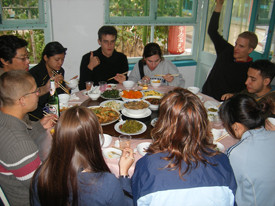Learning Chinese, Eating out!
 Wouldn’t you love to be able to go to your favorite restaurant and order food without a hassle? Learning Chinese at a Chinese restaurant is useful, so try to order food in Chinese as much as possible in order to learn Chinese fast.
Wouldn’t you love to be able to go to your favorite restaurant and order food without a hassle? Learning Chinese at a Chinese restaurant is useful, so try to order food in Chinese as much as possible in order to learn Chinese fast.
It is important that while you are in Beijing that you do 2 things. First is to learn Chinese. Second is to have fun! By following these helpful suggestions you can learn Chinese quickly and try new dishes when dining in Beijing or at a Chinese restaurant. If you don’t want to be stuck ordering the same things each time you go out this guide will help you to learn new foods.
How often should I try this?
You want time to learn and process the new words and food items so I suggest picking a new place or food item once or twice a week. Just follow these 4 simple steps and you will be on your way to tasting everything that Beijing has to offer.
Here are some helpful hints and suggestions as you make your way around Beijing.
1. Start with one character
Learn Chinese food vocabulary by studying the hanzi or character(s) for your favorite meat or vegetable. This way you can start of with a very small vocabulary list and build with each trip.
Let’s use chicken as an example…
Start by learning the Chinese character for chicken or 鸡 (jī). Once you can identify this character you can start to learn other words on the menu.
Practice and memorize this character (soon it will become natural and you will find yourself learning Chinese more quickly). At a restaurant you can always point to the item in the menu and say “this one (zhè ge)” without being able to pronounce the entire name of the dish.
2. Slowly expand your Chinese vocabulary
Once you know what one food character looks like, take time to learn one or two characters for vegetables and sides.
Now you can start pointing at dishes that contain more of the things you want. Also, you can ask the waiter or waitress for items with your favorite foods (e.g. chicken and zucchini or chicken and peanuts).
Be aware! A waiter/waitress may suggest things that you do not like but be adventurous and try something new. If you don’t like this, you will have remembered the name and know now how to say something that you don’t like in the future.
3. Simply ask
Ask the waiter or waitress to repeat the name of the dish to you when they bring it out. Simply ask…what is this called again (zhè shì shén me)? This way you here how it is pronounced locally and can order it with more ease next time.
4. Practice makes perfect!
Increase your ability by becoming familiar with a small number of restaurants. This way you are more comfortable in the environment and use to the menu. It helps to learn Chinese in these environments. If you want a challenge, seek out new restaurants and don’t be hesitant to ask for descriptions of certain items. All you need to know is…
Can I have a menu, please? Qǐng ná yí xìa caì dān?
What is this? Zhè shì shén me?
Is this dish spicy? Zhè ge caì hěn là ma?
I cannot eat… Wǒ bùnéng chī…
What are your specials? Yǒu méi yǒu shén me tè sè caì?
If you can pick up a few words in the description you are on your way to learn Chinese! Delicious food is one very good reason to learn Chinese!
Hints for learning Chinese while eating:
- If you have any ingredients you are allergic to or foods you don’t like it is important for you to know how to say that as well.
- Write down different hanzi or characters from the menu so that you can look them up/practice at home.
- Often food names are described by ‘how’ they are cooked with no description of what is in them. For this, begin to learn words/characters for ‘fried’, ‘strips’, ‘boiled’, and etc.
Want to learn more? Besides shopping, another way to practice your Chinese on a daily basis is by learning Chinese on the go or while you’re out shopping.